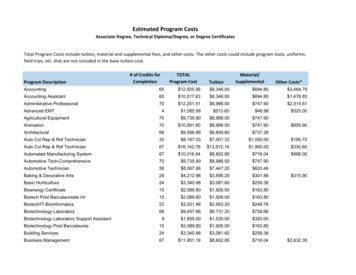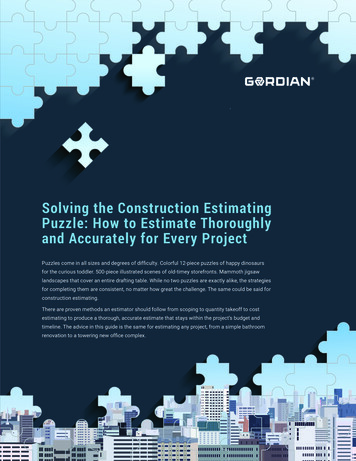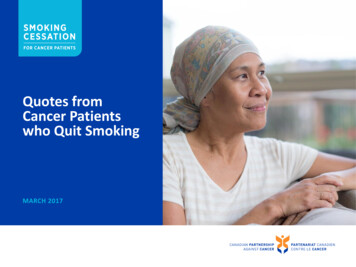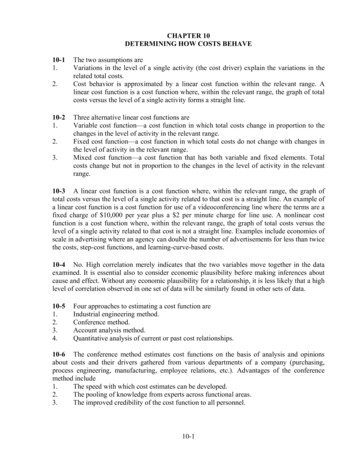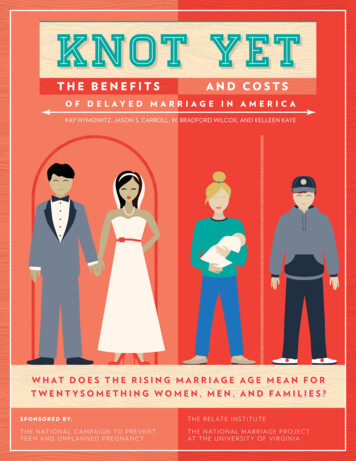
Transcription
Knot YetTHE BENEFITSAND COSTSOF DELAYED MARRIAGE IN AMERICAKAY HYMOWITZ, JASON S. CARROLL, W. BRADFORD WILCOX, AND KELLEEN KAYEW H AT D O E S T H E R I S I N G M A R R I AG E AG E M E A N F O RTWENTYSOMETHING WOMEN, MEN, AND FAMILIES?T H E R E L AT E I N S T I T U T ES P O N S O R E D B Y:T H E N AT I O N A L C A M PA I G N TO P R E V E N TTEEN AND UNPLANNED PREGNANCY1T H E N AT I O N A L M A R R I A G E P R OJ E C TAT T H E U N I V E R S I T Y O F V I R G I N I A
Table of ContentsIn Brief 3Summary 5I Do, but Later 12The Great Crossover 17Other Consequences of Delayed Marriage 20Marriage Delayed: The Why 23The Great Crossover: The Why 26Why the Great Crossover Matters 30Conclusions and Implications 33 2013 by The National Marriage Project at the University of Virginia, The National Campaign to Prevent Teen and Unplanned Pregnancy,and The Relate Institute. All rights reserved. For a print copy, please contact The National Marriage Project at marriage@virginia.edu.
In BriefThe Trends. The age at which men and women marry is now at historic heights—27 forwomen, and 29 for men—and is still climbing. The age at which women have children is alsoincreasing, but not nearly as quickly as the delay in marriage. Knot Yet explores the positiveand negative consequences for twentysomething women, men, their children, and the nationas a whole of these two trends, as well as their economic and cultural causes.The Benefits. Delayed marriage has elevated the socioeconomic status of women, especially more privileged women and their partners, allowed women to reach other life goals, andreduced the odds of divorce for couples now marrying in the United States. Specifically: Women enjoy an annual income premium if they wait until 30 or laterto marry. For college-educated women in their midthirties, this premiumamounts to 18,152. Delayed marriage has helped to bring down the divorce rate in the U.S.since the early 1980s because couples who marry in their early twenties and especially their teens are more likely to divorce than coupleswho marry later.The Costs. Although many men and women have been postponing marriage to their latetwenties and beyond, they have not put off childbearing at the same pace. In fact, for women as awhole, the median age at first birth (25.7) now falls before the median age at first marriage (26.5),a phenomenon we call the Great Crossover, after the “crossover” phenomenon first documentedby the National Center for Family & Marriage Research and explored in greater detail here. Thiscrossover is associated with dramatic changes in childbearing: By age 25, 44 percent of women have had a baby, while only 38 percenthave married; by the time they turn 30, about two-thirds of Americanwomen have had a baby, typically out of wedlock. Overall, 48 percent offirst births are to unmarried women, most of them in their twenties. This crossover happened decades ago among the least economicallyprivileged. The crossover among “Middle American” women—that is,women who have a high-school degree or some college—has been rapid andrecent. By contrast, there has been no crossover for college-educatedwomen, who typically have their first child more than two years after marrying.3
The crossover is cause for concern primarily because children born outsideof marriage—including to cohabiting couples—are much more likelyto experience family instability, school failure, and emotional problems.In fact, children born to cohabiting couples are three times more likelyto see their parents break up, compared to children born to married parents.The Other Costs. Twentysomethings who are unmarried, especially singles, are sig-nificantly more likely to drink to excess, to be depressed, and to report lower levels of satisfaction with their lives, compared to married twentysomethings. For instance: Thirty-five percent of single men and cohabiting men report they are“highly satisfied” with their life, compared to 52 percent of marriedmen. Likewise, 33 percent of single women and 29 percent ofcohabiting women are “highly satisfied,” compared to 47 percent ofmarried women.The Why. Americans of all classes are postponing marriage to their late twenties and thirties for two main reasons, one economic and the other cultural. Young adults are taking longerto finish their education and stabilize their work lives. Culturally, young adults have increasinglycome to see marriage as a “capstone” rather than a “cornerstone”—that is, something they doafter they have all their other ducks in a row, rather than a foundation for launching into adulthood and parenthood.But this capstone model is not working well for Middle Americans. One widely discussed reason for this is that Middle American men are having difficulty finding decent-paying, stablework capable of supporting a family. Another less understood reason is that the capstonemodel is silent about the connection between marriage and childbearing.In Sum. Marriage delayed, then, is the centerpiece of two scripts that help create two different outcomes and two different life chances for the next generation. For the college-educatedthird of our population, it has been a success. For the rest, including large swaths of MiddleAmerica, not so much. Knot Yet concludes by identifying economic, legal, and cultural questionsthat the nation needs to address if we are to help make marriage more realizable for today’syoung adults—the vast majority of whom say they want to be married—realign marriage andparenthood, and make family life more stable for children whose parents don’t enjoy the benefitof a college education.4
SummaryIf you’ve spent any time in the vicinity of a television in recent years, you’ve surely noticed the crowd ofamiable, middle class, young, single urbanites wandering its channels. They wisecrack their way throughshows like New Girl, The Mindy Project, and Girls in the spirit of their prototypes on Friends, Seinfeld, andSex and the City. As they move in and out of jobs and careers, sip coffee or cocktails with their friends, andmeet, share a bed with, and dump or get dumped by boyfriends and girlfriends, these attractive creatures havehelped redefine the twenties and early thirties as a time for self-discovery—a new but crucial life stage beforethe burdens of wedding anniversaries, mortgages, and car seats set in. This genre is the pop-culture offspring ofan important demographic change: the rising age of marriage. The typical American is now well on the way tothirty before tying the knot, later than at any point in history.But their zeitgeisty charm aside, television’s twentysomethings occupy anoutsized cultural space that obscures the reality of life before marriageas it is experienced by many Americans. Unimaginable as it might be toHannah and Marnie from Girls—and to their fans—a large percentage ofunmarried men and women of their age are spending more time duringtheir twenties at 3 a.m. feedings and diaper changes than studying forgrad-school exams or flirting their way through happy hours. In fact, atthe age of 25, 44 percent of women have had a baby, while only 38percent have married; by the time they turn 30, about two-thirds ofAmerican women have had a baby, typically out of wedlock.1 Thesetwentysomethings have now helped to push the baby carriage well infront of marriage for young women in the United States.This report looks beyond popular understandings of con-steadily for all educational and socioeconomic groups,marriage in America affects today’s young women, men,technicians, professors to Walmart cashiers. The mediantemporary twentysomething life to explore how delayedfrom tax lawyers to sanitation workers, bankers to laband their children, as well as some of the reasons behindage of marriage for women is now nearly 27; for men,this shift. Later marriage cannot be called breaking news,almost 29. A historically large number of young adults arenor can it be described as simply good news or bad. Oversingle well into their thirties. As the saying popularized bythe last four decades, the age for tying the knot has risen1rapper Jay-Z has it, “Thirty’s the new twenty.”Data from the 2010 June Current Population Survey.5
FEMALE ANNUAL PERSONAL INCOMEHIGH SCHOOL ORMARRIED UNDER 20 18,234MARRIED OVER 30 22,286COLLEGEV MARRIED UNDER 20 32,263MARRIED OVER 30 50,415SOME COLLEGEGRADUATEThe good news behind these trends is, first, that later marriage allows young men and especially women the chance tofinish their education and to stabilize their careers, finances, and youthful passions before they start a family. “Youngadults today are not ready to get married until they get all their ducks in a row,” write Richard Settersten and BarbaraE. Ray, authors of Not Quite Adults.2 In particular, delayed marriage has improved women’s financial lot. This isespecially true for women with a college degree. The media is full of stories about women who postpone marrying forthe sake of their careers only to find themselves facing romantic purgatory in their thirties, much like the thirty-one-year-old heroine of The Mindy Project. But Mindy’s well-paid and high-status profession—she is an obstetrician—accurately points to the significant upside of her single status. Women with a college degree who wait to marry until atleast thirty, and high-school-educated women without a degree who also wait until thirty, earn more than those whomarry at younger ages. In fact, this report finds that they earn 18,152 and 4,052 more per year, compared to theirsisters who marry before twenty.Second, later marriage has helped to bring down America’s stratospheric divorce rates. Though many people seemunaware of it, the proportion of marriages ending in divorce stopped rising around 1980; it has been falling slowlybut steadily ever since, in part because Americans are getting married at older ages.But if a delay in marriage has produced these happy results, it has also helped to create a troubling one. We callit the Great Crossover, after the “crossover” phenomenon first documented by the National Center for Family& Marriage Research3 and explored in greater detail here. Figure I contains two trend lines, one showing themedian age at which women marry, the other the median age at which women have their first child. Aroundforty years ago, as women starting putting off their wedding vows, they also postponed having children at aboutthe same pace. But after several decades, that was no longer true. Women’s postponement of marriage keptRichard Settersten and Barbara E. Ray, Not Quite Adults: Why 20-Somethings Are Choosing a Slower Path to Adulthood, and Why It’s Good forEveryone (New York: Bantam, 2010), 86.3See Julia Arroyo, Krista K. Payne, Susan L. Brown, and Wendy D. Manning, “Crossover in Median Age at First Marriage and First Birth:Thirty Years of Change,” family profile FP-12-03 (2012), National Center for Family & Marriage Research, http://ncfmr.bgsu.edu/pdf/family profiles/file107893.pdf.26
FIGURE I.THE GREAT CROSSOVERMedian Age at First Marriage and First Birth and the Proportion of First Births to Unmarried Women, 1970-2011100%2890%AG E IN YEA R S2780%2670%2560%2450%40%2330%2220%2110%20197019719 1721973197419751976197719781979198019819 18219819 384198519861987198819819 99019919 19219919 394199519961997199819920 90020020 1020 2020 3020 4020 5020 6020 7020 8020 91020110%Percent of 1st Births UnmarriedMedian Age 1st BirthMedian Age 1st MarriageSOURCES: National Center for Family & Marriage Research. Median age at first marriage, Current Population Survey, 1970-2011 (MarchSupplement); median age at first birth and percentage of first births to unmarried mothers, National Vital Statistics Reports, 1970-2011.soaring while their postponement of childbearing took a more leisurelyclimb. About twenty years ago, the two trend lines crossed, putting theIndeed, in the United States, 48a whole. Now the median age at first marriage for women lags about aunmarried women. Thus, the nationage of first birth before the age of first marriage for American women aspercent of all first births are now toyear behind that of first birth.is at a tipping point, on the verge ofmoving into a new demographic realityOf course, at an individual level, the women delaying marriage are notalways the same as the women who are having children,4 so the Greatwhere the majority of first births in theUnited States precede marriage.Crossover does not mean that a majority of children are now born outsideof marriage. However, as marriage gets delayed to later ages, the odds of having a child outside of marriage increase.Indeed, in the United States, 48 percent of all first births are now to unmarried women. Thus, the nation is at a tipping point, on the verge of moving into a new demographic reality where the majority of first births in the UnitedStates precede marriage.Digging a little deeper, we see that what we call “Middle American” women—that is, moderately educatedwomen with a high-school degree and perhaps a year or two of college—are playing a leading role in the trend.They make up more than half of the young women in the United States,5 and though they are following in thefootsteps of their more educated sisters in postponing marriage, they are not adopting their strategy of delayingparenthood. In fact, as Figure II indicates, the Great Crossover is concentrated among these Middle AmericanWhile these populations largely overlap, they are not completely identical. According to the 2010 June Current Population Survey, 73.8percent of women aged forty to forty-four had ever married and had children, 10.9 percent had ever married and had no children, 7.4 percenthad never married and had children, and 7.9 percent had never married and had no children.5According to the 2012 Current Population Survey, 54 percent of women aged twenty-five to twenty-nine have a high-school diploma or somecollege, 37 percent are college educated, and 9 percent have less than a high-school diploma; likewise, 59 percent of men aged twenty-five totwenty-nine have a high-school diploma or some college, 30 percent are college educated, and 11 percent have less than a high-school diploma.47
FIGURE IIA. Median Age at First Marriage and Mean Age at FirstBirth for Women College Graduateswomen; there has been no crossover among college-AGE IN Y E A RSeducated women. Middle American women crossed overaround 2000, and since then the gap between the age ofmarriage and age of childbearing among Middle American women has grown considerably. Today, as a group,they have their first child more than two years before theyget to the church or city hall, to the point where 58 percent33312927252321191715of their first births are now out of wedlock. These 0%50%40%30%20%10%0%Percent of First Births to Unmarried MothersMean Age First Birthare not spending their twenties finding themselves or“getting their ducks in a row”; they are providing for andMedian Age First MarriageFIGURE IIB. Median Age at First Marriage and Mean Age at FirstBirth for Women w/ Less Than High School Educationraising young children, often without a husband—as Fig-ure II also indicates—a path that has long been associatedAG E I N Y E A RSprimarily with more disadvantaged women.6Young adults are putting off marriage—and the evidenceis strong that they are putting it off, not writing it off—fora number of reasons. Marriage has shifted from being the33312927252321191715cornerstone to the capstone of adult life.7 No longer %60%50%40%30%20%10%0%Percent of First Births to Unmarried Mothersfoundation on which young adults build their prospects forMedian Age First MarriageMean Age First Birthfuture prosperity and happiness, marriage now comes onlyFIGURE IIC. Median Age at First Marriage and Mean Age at First Birthfor Women w/ a High School Diploma or Some Collegeafter they have moved toward financial and psychologicalindependence. It’s not hard to understand this mindset,AG E I N YE AR Sespecially given that many of today’s young adults arechildren of divorce and express worry about divorce them-selves; they view marriage as something that should not beundertaken without a suitable exit strategy. Unfortunately,declining job prospects for Middle Americans may simplyput this capstone ideal out of reach for 9020002010100%90%80%70%60%50%40%30%20%10%0%Percent of First Births to Unmarried MothersMean Age First BirthMoreover, one of the primary reasons for getting married—Median Age First MarriageSOURCES: National Vital Statistics Birth Datafiles, 1970-2010; Decennial Census PublicUse Microdata Samples, 1970-2000; American Community Survey, 2010.starting a family—is increasingly viewed as a relic of the past.The institution of marriage, and even the presence of twoparents, are seen as nice but not necessary for raising children. Thus, even when a baby is coming, many young adults see no needto rush to the altar. Finally, many young adults in romantic relationships greatly overestimate the chances that they have alreadymet their future spouse, which makes them vulnerable to sliding into parenthood even though they haven’t married.8See Matthew McKeever and Nicholas H. Wolfinger, “Thanks for Nothing: Income and Labor Force Participation for Never-married Mothers Since 1982” Social Science Research 40 ( January 2011): 63–76.7See Andrew J. Cherlin, The Marriage-Go-Round: The State of Marriage and the Family in America Today (New York: Vintage, 2009).8Kelleen Kaye, Katherine Suellentrop, and Corinna Sloup, The Fog Zone: How Misperceptions, Magical Thinking, and Ambivalence Put YoungAdults at Risk for Unplanned Pregnancy (Washington, DC: National Campaign to Prevent Teen and Unplanned Pregnancy, 2009), 8
UGR A DUAT ESC H O O LCO LLEGE GRA DUATESTHE DIVIDED LIFE OF 20SOMETHINGS:The Early 20sHIGH SCHOOL or SOME COLLEGE9
FIGURE IIIA. Union Dissolution Within 5 Years ofBirth of First Child, 20-29 year-old MothersIf young mothers and fatherswere actually marrying eachother a year or two after the arrival of their bundle of joy andremaining together, the GreatCrossover might not be much toworry about. That’s not what’shappening. Middle Americanmothers are often living withtheir child’s father at the timethey give birth—in fact, theybegin to cohabit at about thesame age they used to marry—but these relationships oftendon’t last. As Figure III indicates,nearly 40 percent of cohabitingtwentysomething parents whohad a baby between 2000 and2005 split up by the time theirchild was five; that’s three times45%39%*40%35%30%25%20%13%*15%10%5%0%Married at 1st BirthNOTE: Figure depicts the percent of couples who ended their relationship within the first five years after thefirst birth of a child where the mother was 20-29 years old. An asterisk (*) above the bar indicates astatistically-significant difference (p 0.05) between the groups, controlling for maternal age at firstbirth, race/ethnicity, education level, and urbanicity derived from logistic regression models (notshown). The sample is of women who had a birth between 2000-2005.FIGURE IIIB. Family Transitions Within 5 Years of Birth of First Child,20-29 year-old Mothers, by Marital Status at d when they had a child.The cohabitants were also morethan three times more likely thanmarried parents to move on to acohabiting or marital relationshipwith a new partner if their rela-18%*13%15%*5%Women with At LeastOne Family Transitionhigher than the rate for twen-tysomething parents who wereCohabiting at 1st BirthMarriedCohabitingWomen with Two orMore FamilyTransitionsSingle, Never MarriedNOTE: Figure depicts the percent of women who experienced at least one or two or more family transitionswithin the first five years after the first birth of a child. Family transitions refer to either the start of amarriage or cohabiting relationship or the end of such a relationship. If a cohabiting relationshipprogresses to marriage, this transition is not counted. An asterisk (*) above the bar indicates a astatistically-significant difference (p 0.05) between the married mothers and the other two groups,controlling for maternal age at first birth, race/ethnicity, education level, and urbanicity derived fromlogistic regression models (not shown).SOURCE: National Survey of Family Growth, 2006-2010.tionship did break up.9 Researchers paint a sorry picture of the effect these disruptions have; children sufferemotionally, academically, and financially when they are thrown onto this kind of relationship carousel.10This isn’t to say that unmarried mothers and fathers are faring much better emotionally than their children.New findings in this report show that unmarried twentysomething parents, both women and men, reporthigh rates of depression and dissatisfaction; the mood among cohabiting parents is a little better than thatThe instability associated with cohabitation illustrated in Figure III is partly a consequence of the fact that cohabiting couples have lesseducation and income than their married peers, as we note below. But even after controlling for socioeconomic differences, children born tocohabiting couples are significantly more likely to experience the dissolution of their parents’ relationship, and to be exposed to a new romanticpartner in the household.10See Cherlin, Marriage-Go-Round; Paul R. Amato, “The Impact of Family Formation Change on the Cognitive, Social, and EmotionalWell-being of the Next Generation,” Future of Children 15 (Fall 2005): 75–96.910
of singles but still gloomier than that of married mothers and fathers. Actually, singles and cohabitants withoutchildren are also more likely to be depressed than are young married men and women. Compared to marriedtwentysomething men, their single and cohabitingpeers are less satisfied with their lives and markedlyCompared to married twentysomething men,more likely to drink too much, making some of themtheir single and cohabiting peers are less satisfiedreal-life versions of the childmen who inhabit thewith their lives and markedly more likely to drinkfilms of Judd Apatow (think Knocked Up) or characterstoo much, making some of them real-life versionsplayed by Adam Sandler, Owen Wilson, and the like.of the childmen who inhabit the films of JuddOf course, putting off marriage is working well enough forby Adam Sandler, Owen Wilson, and the like.Apatow (think Knocked Up) or characters playedthe Carries and Hannahs of American society. These arewomen who, as Hanna Rosin writes in The End of Men, “have more important things [than relationships, marriage, andchildren] going on, such as good grades and internships and job interviews and a financial future of their own.” 11But women who aren’t dreaming about interning at Condé Nast or interviewing at Morgan Stanley may seethings rather differently. For a woman whose nine-to-five is spent filling out insurance forms in a doctor’s officeor even overseeing a sales staff at Staples, a baby might seem more enriching than a dollar-an-hour raise. If mar-riage is now only attainable for those who are financially set—a goal they’re not sure of ever reaching—they oftenchoose or drift “unintentionally” into parenthood before they are ready to marry. Forty years ago, when marriagestill operated as the cornerstone of adulthood, only a small percentage of the births to women in their early twenties were nonmarital; by 2010, it was the large majority. If thirty is the new twenty,If thirty is the newtoday’s unmarried twentysomething moms are the new teen mothers.twenty, today’s unmarriedtwentysomething momsare the new teen mothers.Marriage delayed, then, is the centerpiece of two scripts that help create two differ-ent outcomes and two different life chances for the next generation. For the collegeeducated third of our population, it has been a success. For the rest, not just thetruly disadvantaged but large swaths of Middle America, not so much. Perhaps there is a better path for the youngwomen—and men—whom we don’t see on the gentrified streets of television sitcoms.11Hanna Rosin, The End of Men and the Rise of Women (New York: Riverhead, 2012), 21.11
I Do, but LaterWith the exception of the three decades following World War II—including the1950s era of the (“Leave It to Beaver”) Cleavers and the (“Adventures of Ozzieand Harriet”) Nelsons—Americans were never ones to rush into marriage.While in most cultures, women have typically married in their teens and men a few years later,people in the United States and other Anglo countries have been notable for their leisurelyapproach to settling down. In 1900, the median age of marriage for women in the UnitedStates was a little over 23 and for men, around 26. In the past several decades, however, twentysomethings have been pushing marriage into even later years, taking us into entirely newdemographic territory.FIGURE 1. Median Age at First Marriage in the United 19891991199319951997199920020 103200520020 7092011AGE IN YEARS29MenWomenSOURCE: Current Population Survey, 1947-2011.Let’s look at some of the numbers. The age of marriage has been rising steadily since 1970(see Figure 1) and, in fact, in 1980 women passed the previous historical high, a bench-mark reached by men ten years later. Today in the United States, as Hollywood has happilydiscovered, a greater proportion of twentysomethings are unmarried than ever before (seeFigure 2). Much of that increase can be explained by delayed marriage. Back in the day—say, 1970—over 60 percent of women aged twenty to twenty-four and almost all (90 per-cent) of women aged twenty-five to twenty-nine had married; in 2010, those numbers hadplummeted to 20 percent and about 50 percent. Men followed a similarly dramatic pattern.In 1970, almost half of men aged twenty to twenty-four were married, and a remarkable12
FIGURE 2. Percentage of Women Never Married, by Age100%80%80 percent of those twenty-60%five to twenty-nine had alsosettled down. By 2010, thosenumbers had plunged to40%20%0%slightly more than 10 per-197520-24 yearscent and less than 40 29 yearsSOURCE: Current Population Survey, 1970-2010.(Figure 3). Over the pastforty years, then, marriage in1970FIGURE 3. Percentage of Men Never Married, by Agethe early- or midtwenties hasbeen going along the same100%path as the standard-shift80%increasingly outdated.40%car—not exactly a relic, but60%20%When we tease apart this trend0%1970by education, we notice some-thing striking, especially in the197520-24 years198019851990199525-29 yearsSOURCE: Current Population Survey, 1970-2010.past decade. During that time,the percentage of college-educated women twenty-five to twenty-nine years old who were stillsingle went from 46 to 55 percent (Figure 4). An increase like this makes researchers sit up andtake notice, but it is not quite a demographic earthquake, especially because college-educatedwomen have traditionally been more likely to postpone marriage than have other women.The story for women without a college degree, on the other hand, does reach the level of a demo-graphic headline. Between 1990 and 2000, the percentage of never-married women in theirlate twenties in two groups—high-school dropouts and those with a high-school degreeand maybe some college—rose modestly by about 5 percent-Women doctors, teachers,medical technicians, orwaitresses are now all equallylikely to postpone marriage totheir late twenties.age points. Starting in 2000, however, the percentage of still-single women in both groups jumped more than 15 points. Asa result, the age of marriage for women of all education levelsconverged near the same historically high mark; today, morethan 50 percent of all women in this age group are not married.Whereas in the past, women from Vassar to the University ofNorth Carolina were always known for marrying later than their less-educated sisters, thatis no longer the case. Women doctors, teachers, medical technicians, or waitresses are nowall equally likely to postpone marriage to their late twenties.13
FIGURE 4. Percentage of 25-29 year-old Women Who HaveNever Married, by EducationUnsurprisingly, men of all classeshave also become members of the60%marrying habits of those without40%delayed marriage movement. The50%1230%a college education are looking20%much more similar to those with a1990Alldegree than they did a decade ago.Today, across all educational levels,2000LTHSHS/SC2010Col gradSOURCE: Decennial Census Public Use Microdata Samples, 1990-2000;American Community Survey Public Use Microdata Samples, 2010.almost two-thirds of men agedNOTE: Throughout this report, "LTHS" refers to adults without a highschool degree, "HS/SC" refers to adults with a high school degree orsome college but no bachelor's degree, and "Col grad" refers toadults with a bachelor's degree or a graduate degree.twenty-five to twenty-nine areunmarried. But in a moment, we’llsee why this class convergencedoes not signify anything remotely like class solidarity.Some might see marriage delayed as proof that young people, being especially open to change,think marriage is obsolete, or that being naturally rebellious, they don’t believe in the institutionanymore. Not at all. The large majority of young adults say theyhope to marry someday. True, in the final quarter of the twentiethThe large majority of youngadults say they hope to marrycentury, the number of high-school seniors who believed they’d waitfive or more years after high school to get married grew significant-someday.ly.13 But, as Figure 5 indicates, about 80 percent of young-adult menand women continued to rate marriage as an “important”
Knot Yet concludes by identifying economic, legal, and cultural questions that the nation needs to address if we are to help make marriage more realizable for today’s young adults—the vast majority of whom say they




